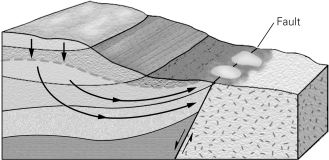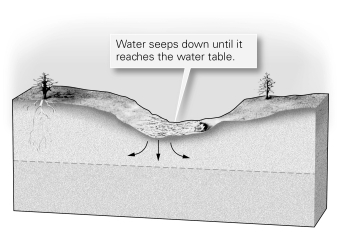A) above the regional water table, within permeable rock or sediment
B) above the regional water table, within impermeable rock or sediment
C) below the regional water table, within impermeable rock or sediment
D) below the regional water table, within permeable rock or sediment
F) All of the above
Correct Answer

verified
Correct Answer
verified
Multiple Choice
An aquifer that is isolated from Earth's surface by an aquitard is ____________.
A) supersaturated
B) confined aquifer
C) unconfined
D) unsaturated zone
F) B) and C)
Correct Answer

verified
Correct Answer
verified
Multiple Choice
Rock or sediment between the water table and the land surface represents a(n) ____________.
A) aquitard
B) confined aquifer
C) unconfined aquifer
D) unsaturated zone
F) A) and C)
Correct Answer

verified
Correct Answer
verified
Multiple Choice
Which of the following is not evidence for karst topography?
A) salt beds
B) sinkholes
C) limestones
D) disappearing streams
F) A) and C)
Correct Answer

verified
Correct Answer
verified
Multiple Choice
A body of permeable,saturated rock or sediment into which water can percolate directly from the ground surface is termed a(n) ____________.
A) aquitard
B) confined aquifer
C) unconfined aquifer
D) unsaturated zone
F) A) and D)
Correct Answer

verified
Correct Answer
verified
Multiple Choice
Besides its immense size,what else is unusual about Carlsbad Caverns in southeastern New Mexico?
A) Geologists think the system was produced by sulfuric acid rather than carbonic acid.
B) The caverns are within a deposit of rock salt rather than limestone.
C) The caverns were formed within the span of just a few days in 1937.
D) Although there are conduits to the surface, the caverns do not host a population of bats.
F) B) and C)
Correct Answer

verified
Correct Answer
verified
True/False
Unconsolidated sediment typically has greater porosity than lithified rock which it forms.
B) False
Correct Answer

verified
Correct Answer
verified
Multiple Choice
Material through which water readily flows is termed ____________.
A) fluent
B) porous
C) permeable
E) All of the above
Correct Answer

verified
Correct Answer
verified
Multiple Choice
The rate of groundwater flow per unit area through a body of rock or sediment depends ____________.
A) only on the slope of the water table locally
B) only on the porosity of the rock or sediment
C) on the slope of the water table and the porosity of the rock or sediment
D) on the slope of the water table and the permeability of the rock or sediment
F) A) and C)
Correct Answer

verified
Correct Answer
verified
Multiple Choice
In the figure below,the flecked material to the right of the fault would be considered a(n) ____________. 
A) aquifer
B) aquitard
C) artesian well
D) perched aquifer
F) None of the above
Correct Answer

verified
Correct Answer
verified
Multiple Choice
Topography dominated by depressions formed by the collapse of caves is termed ____________.
A) valley and ridge
B) karst
C) horst and graben
E) A) and C)
Correct Answer

verified
Correct Answer
verified
Multiple Choice
A well-sorted sediment will have ____________ porosity than a poorly sorted sediment.
A) greater
B) less
C) approximately the same
E) All of the above
Correct Answer

verified
Correct Answer
verified
Multiple Choice
Land subsidence is likely when ____________.
A) groundwater recharge occurs
B) the Ca and Mg content of groundwater increases
C) the water table changes
D) discharge lowers the water table
F) B) and C)
Correct Answer

verified
Correct Answer
verified
True/False
Neither methane nor hydrogen sulfide are naturally-occurring in well-water.
B) False
Correct Answer

verified
Correct Answer
verified
Multiple Choice
In unfractured rock and sediment,water molecules usually take a ____________.
A) straight path
B) wandering path
C) circular path
E) B) and C)
Correct Answer

verified
Correct Answer
verified
Multiple Choice
If the cross-section shown here were typical of the main channel of a long river,would you expect the river to dry up as you followed it downstream? 
A) Yes, because the water is contaminated.
B) Not if there were additional tributaries entering it downstream.
C) Yes, because it is in a desert.
D) No.
F) A) and B)
Correct Answer

verified
Correct Answer
verified
Multiple Choice
Extensive pumping of fresh groundwater from wells near a seacoast is most likely to induce ____________.
A) saline intrusion; with time the well will start to deliver saline water
B) saline expulsion; with time the freshwater/saline water interface within the aquifer will be pushed downward and seaward
C) mineral deposition of salts within the aquifer
E) A) and C)
Correct Answer

verified
Correct Answer
verified
Multiple Choice
Groundwater ____________.
A) rarely, if ever, contains dissolved ions
B) dissolves calcite and limestone
C) can contain dissolved minerals but can never precipitate minerals out of solution
D) can precipitate minerals but only if the ions that would form the mineral in question are undersaturated in the water
F) A) and D)
Correct Answer

verified
Correct Answer
verified
True/False
Freshwater lakes are always discharge areas.
B) False
Correct Answer

verified
Correct Answer
verified
Multiple Choice
Which factor listed here would not affect the flow of water at a spring?
A) the concentrations of various ions and man-made pollutants
B) conditions of either drought or heavy rainfall at the recharge area
C) the interconnectedness of fractures or pore spaces leading to the spring
D) a decline in the water table in the direction from which groundwater feeds the spring
F) A) and B)
Correct Answer

verified
Correct Answer
verified
Showing 21 - 40 of 54
Related Exams